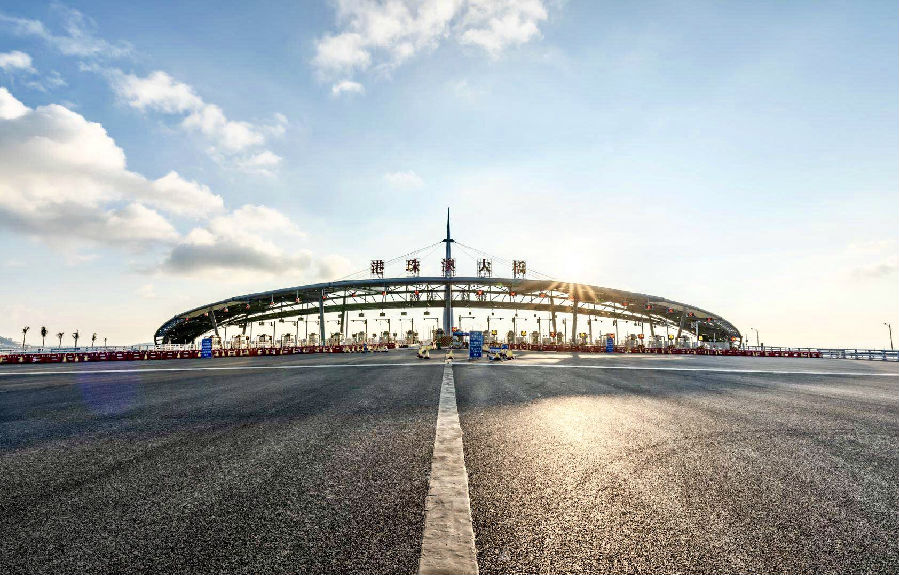When the Hong Kong-Zhuhai-Macau Bridge, orHZMB, was completed in January of 2018,
2018年1月���,港珠澳大橋竣工����,
it became the longest sea crossing bridge in theworld.
成為當今世界上最長的跨海大橋。
With a total length of 55 kilometers, the structure isimpressive to behold,
該橋全長55公里��,橋的結(jié)構(gòu)光是看上一眼就會給人留下深刻的印象����,
but the engineering behind it is even moreincredible.
但這一結(jié)構(gòu)背后的工程學更加讓人難以置信。
The goal of the bridge was to connect
這座橋的目標是連接
the major population center of Hong Kong on one side of the Pearl River Delta to Macau andZhuhai on the other.
珠三角一頭的香港這一人口大區(qū)和另一頭的澳門和珠海�。
Normally to go between the cities requires driving around a large bay,
在這三個城市之間穿行通常需要開車繞過一個大海灣,
and a more direct path could take two hours off the trip.
而更直接的路線可以讓人們節(jié)省兩個小時的車程�����。
Making such a long bridge required careful planning from the HZMB’s designers.
要建造這樣一座大橋�,港珠澳大橋的設(shè)計者們需要進行精心的規(guī)劃和設(shè)計�。
They had to build it to withstand the annual typhoon season, the occasional earthquake, andthe ever-present sea.
要讓建造出來的橋能夠抵御每年都有的臺風季,偶爾發(fā)生的地震�����,以及始終都在那里的大海。
And their goal is to make it last for for 120 years.
而他們的目標是讓這座橋(在這樣的條件下也)能延續(xù)120年����。
They also had to account for its location,
他們還要考慮這座橋的位置:
cutting across five shipping navigation channels
這座橋?qū)M跨五個航運航道,
and the flight path of aircraft taking off and landing at Hong Kong International Airport.
還要經(jīng)過香港國際機場的起降航線����。
And finally, they had to consider the local marine life, like the chinese white dolphin,
最后,他們還要考慮當?shù)氐暮Q笊?����,比如中華白海豚�,
and the impact the construction and presence of the bridge would have on the ecology ofthe region.
以及橋梁的建設(shè)和存在將對該地區(qū)的生態(tài)產(chǎn)生的影響。
The first most obvious challenge when building over water is the fact that there’s no land tobuild on.
在水上架橋的第一個最明顯的挑戰(zhàn)是沒有土地可以依托���。
That’s kind of the whole point of the bridge.
這恰好也是港珠澳大橋整座橋最關(guān)鍵的地方��,
So you need to start with a stable base.
所以�,首先���,他們得給橋打一個穩(wěn)定的基礎(chǔ)�。
However the first solid ground you run into under water isn’t usually ideal either.
然而,你在水下遇到的第一個相對堅固的地面通常并不是理想的打樁之地�����。
In this case, there were weak marine deposits that don’t make for a solid foundation.
就拿架橋來說�,不那么堅固的海洋沉積物就無法打造成堅實的橋梁基礎(chǔ)。

To overcome this, builders drove long poles called piles down through the sediment.
為了克服這一困難�����,施工的工人們會把所謂的“(鋼管)樁”這種長桿打入海底的沉積物��。
Piles used in the Hong Kong link road portion of the bridge could be as wide as 2.8 meters,
港珠澳大橋香港一側(cè)的輔路部分所有的鋼管樁寬度可達2.8米��,
and in a few cases were over 100 meters long to reach a stable foundation.
為了實現(xiàn)橋基的穩(wěn)定�,有的鋼管樁的高度甚至超過了100米。
With the piles in place, workers put a cap over them.
鋼管樁就位后�����,工人們便對其進行封頂����。
HZMB designers placed many of these caps under the sea floor in order to minimize theirimpact on the flow of water.
為了盡可能減小大橋?qū)λ鞯挠绊懀壑榘拇髽虻脑O(shè)計師們進行了多處封頂操作�。
From the pile cap rises a single column called a pier, and spans with the road surface on themstretch from one pier to the next.
在這些頂蓋上立起單柱,即所謂的“橋墩”��,再支起橋臺�����,橋臺上則承載著從一個橋墩延伸到另一個橋墩的路面�����。
To minimize the number of piers and reduce the ecological impact,
為盡量減少橋墩數(shù)目�,縮小對生態(tài)的影響,
long spans of up to 180 meters were used where applicable.
他們將橋臺設(shè)計得較長�,有的橋臺長度甚至達到了180米長。
These long spans are strong enough to support themselves in between piers,
這些長跨度的橋臺非常堅固����,足以支撐起它們在兩個橋墩之間的自重。
but they’re still not long enough to leave a gap for the large vessels that use those five majorshipping lanes into the bay.
但即便如此����,這些橋臺的長度還是不夠容納靠這五條主要航道出入海灣的大型船只。
For those portions of the bridge, engineers had to switch up their design.
對于橋梁的這些部分�����,工程師們不得不改變設(shè)計。
Across three of the lanes, they used a cable-stay bridge design,
在經(jīng)過五個航道中的三個航道的位置�����,設(shè)計師們采用了斜拉橋的設(shè)計����,
where large towers are anchored with cables directly to the deck.
巨大的索塔直接用纜索固定在橋面上。
The towers absorb the compression forces on the spans.
索塔會消化路面對橋臺的部分壓力��。
For two of those navigation channels through, cable-stayed bridges were not an option.
在另外兩條(深海主)航道經(jīng)過的地方����,斜拉橋這種設(shè)計就不可行了。
The tall towers would pose a risk to flights from the nearby airport.
因為高高的索塔會對往返附近(香港赤喇角)機場的航班構(gòu)成威脅����。
So the designers decided to take part of the bridge underwater.
于是,設(shè)計師們決定將這一部分橋體放到水下���。
6.7 kilometers of the HZMB’s length is a tunnel,
港珠澳大橋有6.7公里都是海底隧道���,
connected to the bridge with an artificial island on each end.
兩端各通過一座人工島與水上部分的橋體相連。
This solved the air and sea traffic problems in one fell swoop,
這一設(shè)計一舉解決了??諆煞矫娴慕煌▎栴}����,
but posed another problem for the local marine life.
但也給當?shù)睾Q笊飵砹寺闊?
The usual process of making artificial land starts with dredging out the muck on the seafloorand filling it with sand,
因為搭建人工島通常要先挖掉海底的淤泥繼而填上沙子���,
then building a sea wall on top of that and finally filling in the area within the sea wall.
之后在上面建一個海堤,最后填滿海堤內(nèi)的區(qū)域���。
But the process of dredging muddies the water with disturbed and dumped sediment.
問題是��,疏浚的過程會使泥沙淤積在水中�。
This suspended sediment can consist of organic material, nutrients, or contaminants thataffect the ecosystem in positive and negative ways.
懸浮的沉積物可能含有會給周圍的生態(tài)系統(tǒng)造成或正面或負面影響的有機物�����、營養(yǎng)物質(zhì)或污染物�����。
When the dust settles, it can blanket and smother communities living on the seabed.
泥沙沉積后還會覆蓋��,甚至窒息生活在海底的生物群����。
Past projects that used dredging have played a part in the decline of the Chinese WhiteDolphin population in the area.
過去的疏浚工程就對該地區(qū)中國白海豚數(shù)量的減少產(chǎn)生了一定的影響�����。
To try and avoid harming the dolphin population further the builders used a completelydifferent approach.
為了避免進一步傷害海豚種群���,建造者這次使用了截然不同的一種方法。
First they installed a matrix of stone columns running down to the sturdier sand and clay.
他們先安裝了一排石柱�����,這些石柱直接打入相對堅硬的沙子和粘土層����。
Then they drove

